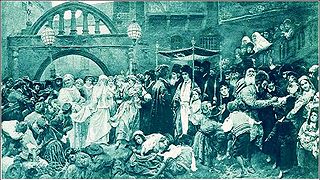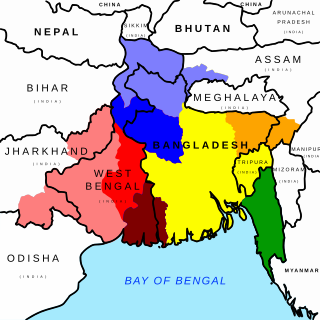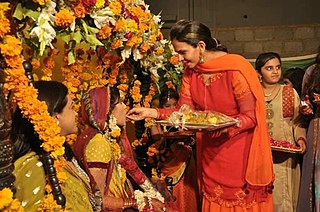Related Research Articles

A wedding is a ceremony where two people are united in marriage. Wedding traditions and customs vary greatly between cultures, ethnic groups, religions, countries, and social classes. Most wedding ceremonies involve an exchange of marriage vows by a couple, presentation of a gift, and a public proclamation of marriage by an authority figure or celebrant. Special wedding garments are often worn, and the ceremony is sometimes followed by a wedding reception. Music, poetry, prayers, or readings from religious texts or literature are also commonly incorporated into the ceremony, as well as superstitious customs.

A wedding reception is a party usually held after the completion of a marriage ceremony as hospitality for those who have attended the wedding, hence the name reception: the couple receive society, in the form of family and friends, for the first time as a married couple. Hosts provide their choice of food and drink, although a wedding cake is popular.

An engagement or betrothal is the period of time between the declaration of acceptance of a marriage proposal and the marriage itself. During this period, a couple is said to be fiancés, betrothed,intended, affianced, engaged to be married, or simply engaged. Future brides and grooms may be called fiancée (feminine) or fiancé (masculine), the betrothed, a wife-to-be or husband-to-be, respectively. The duration of the courtship varies vastly, and is largely dependent on cultural norms or upon the agreement of the parties involved.
A dowry is a payment, such as property or money, paid by the bride's family to the groom or his family at the time of marriage. Dowry contrasts with the related concepts of bride price and dower. While bride price or bride service is a payment by the groom, or his family, to the bride, or her family, dowry is the wealth transferred from the bride, or her family, to the groom, or his family. Similarly, dower is the property settled on the bride herself, by the groom at the time of marriage, and which remains under her ownership and control.

The Kalenjin are a group of tribes designated as Highland Nilotes and are descended from Maliri people (thus related to Daasanach of Ethiopia.) The Kalenjin are cousins with Datooga people of Tanzania. In contrast, their designation groups them with other Nilotes including Maasai, Luo, Turkana and Nuer, Dinka among others. They are indigenous to East Africa, residing mainly in what was formerly the Rift Valley Province in Kenya and Eastern slopes of Mount Elgon in Uganda. Upon their arrival in the forest region of Mau, the Kalenjin assimilated the aboriginal hunter-gatherer people known as Okiek. They number 6,358,113 individuals per the Kenyan 2019 census and an estimated 300,000 in Uganda mainly in Kapchorwa, Kween and Bukwo districts. They have been divided into 11 culturally and linguistically related tribes: Kipsigis, Nandi (937,000), Sebei Keiyo, Marakwet, Sabaot (296,000), Pokots, Tugen, Terik, Sengwer, and Ogiek. The Kalenjin speak the Nandi–Markweta languages but can also be inclusive of Akie language in Tanzania and Pokot language spoken in Kenya; all being classified collectively as Kalenjin Language; while in combination with Datooga languages of Tanzania, this cluster is called Southern Nilotic languages.

The Bukusu people are one of the 17 Kenyan tribes of the Luhya Bantu people of East Africa residing mainly in the counties of Bungoma and Trans Nzoia. They are the largest tribe of the Luhya nation, with 1,188,963 identifying as Bukusu in the 2019 Kenyan census. They speak the Bukusu dialect.
Lobolo or lobola in Zulu, Xhosa, Swazi, Silozi, Shona and northern and southern Ndebele, and mamalo in Tshivenda language, sometimes referred to as "bride wealth" or "bride price" is a property in livestock or kind, which a prospective husband, or head of his family, undertakes to give to the head of a prospective wife's family in gratitude of letting the husband marry their daughter.

A Jewish wedding is a wedding ceremony that follows Jewish laws and traditions. While wedding ceremonies vary, common features of a Jewish wedding include a ketubah which is signed by two witnesses, a chuppah or huppah, a ring owned by the groom that is given to the bride under the canopy, and the breaking of a glass.

A Bengali Muslim wedding A true Bengali Muslim wedding includes very few rituals and ceremonies that may span to 3 days max. In most cases, it starts with the Paka Dekha ceremony(promising of marriage). Then, nikkah(marriage registration) which is done by a kaji with a fixed denmohor(payable to wife) and it ends with the Bou Bhat ceremony that is popular as the wedding reception arranged by the groom's family.

Marriage in Pakistan pertains to wedding traditions established and adhered by Pakistani men and women. Despite their local and regional variations, marriages in Pakistan generally follow Islamic marital jurisprudence., they are very similar to north Indian weddings traditionally and culturally. Socially, marriages are not only seen as a union between a husband and a wife, but also an alliance between their respective families. These traditions extend to other countries around in the world where Overseas Pakistani communities exist.
A Brunei Malay wedding has many types of ceremonies.
Chinese pre-wedding customs are traditional Chinese rituals prescribed by the 禮記 [láih gei], the 儀禮 [yìh láih] and the 白虎通 [baahk fú tùng] condensed into a series of rituals now known as the 三書六禮 [sàam syù luhk láih]. Traditionally speaking, a wedding that incorporates all six rites is considered a [daaih chéui].
Ukrainian wedding is the traditional marriage ceremony in Ukrainian culture, both in Ukraine and in the Ukrainian diaspora. The traditional Ukrainian wedding featured a rich assortment of folk music and singing, dancing, and visual art, with rituals dating back to the pre-Christian era. Over time, the ancient pagan traditions and symbols were integrated into Christian ones.

Mursik is a traditional fermented milk variant of the Kalenjin people of Kenya. It can be made from cow or goat milk and is fermented in a specially made calabash gourd locally known as a sotet. The gourd is lined with soot from specific trees, such as the African senna, which add flavor to the fermented milk. It is normally consumed with ugali or on its own and is served at room temperature or chilled.

Muslim marriage and Islamic wedding customs are traditions and practices that relate to wedding ceremonies and marriage rituals prevailing within the Muslim world. Although Islamic marriage customs and relations vary depending on country of origin and government regulations, both Muslim men and women from around the world are guided by Islamic laws and practices specified in the Quran. Islamic marital jurisprudence allows Muslim men to be married to multiple women.

Bride price, bride-dowry, bride-wealth, or bride token, is money, property, or other form of wealth paid by a groom or his family to the woman or the family of the woman he will be married to or is just about to marry. Bride dowry is equivalent to dowry paid to the groom in some cultures, or used by the bride to help establish the new household, and dower, which is property settled on the bride herself by the groom at the time of marriage. Some cultures may practice both simultaneously. Many cultures practiced bride dowry prior to existing records.
Weddings in Myanmar, considered auspicious occasions in Burmese culture, reflect various ethnic, religious, and regional traditions. Depending on an individual's family social economic status, personal preferences and titles held, Burmese weddings can be religious or secular, and extravagant or simple. Wedding expenses are covered by the groom's family. Myanmar is a predominantly Buddhist country, and many wedding customs and traditions are influenced by Buddhism.
Kalenjin names are primarily used by the Kalenjin people of Kenya and Kalenjin language-speaking communities such as Murle in Ethiopia, Sebei of Uganda, Datooga, Akie and Aramanik of Tanzania.
Contemporary Kalenjin culture is a product of its heritage, the suite of cultural adoptions of the British colonial period and modern Kenyan identity from which it borrows and adds to.
References
- ↑ "Transitions". renee.co.ke. December 23, 2013. Retrieved August 11, 2019.
- ↑ Ndanyi, Mathews (August 9, 2019). "Ruto attends his brother's dowry negotiation in Eldoret". The Star (Kenya) . Retrieved August 11, 2019.
- ↑ "Kenyan wedding traditions". lovemattersafrica.com. 15 January 2016. Retrieved August 11, 2019.
- ↑ "Mursik season!". nation.co.ke. January 2, 2018. Retrieved August 11, 2019.
- ↑ "Interesting steps in traditional marriage ceremony amongst the Kalenjin community". hivisasa.com. July 2, 2018. Retrieved October 18, 2018.
- ↑ "Traditional Koito wedding". omgvoice.com. July 2, 2018. Retrieved October 18, 2018.
- ↑ "Kalenjin traditional wedding, The fusion of culture". africaiblogyou.wordpress.com. December 14, 2016. Retrieved October 18, 2018.
- ↑ "Dowry and wedding on same day". parentsafrica.com. August 31, 2015. Archived from the original on October 18, 2018. Retrieved October 18, 2018.